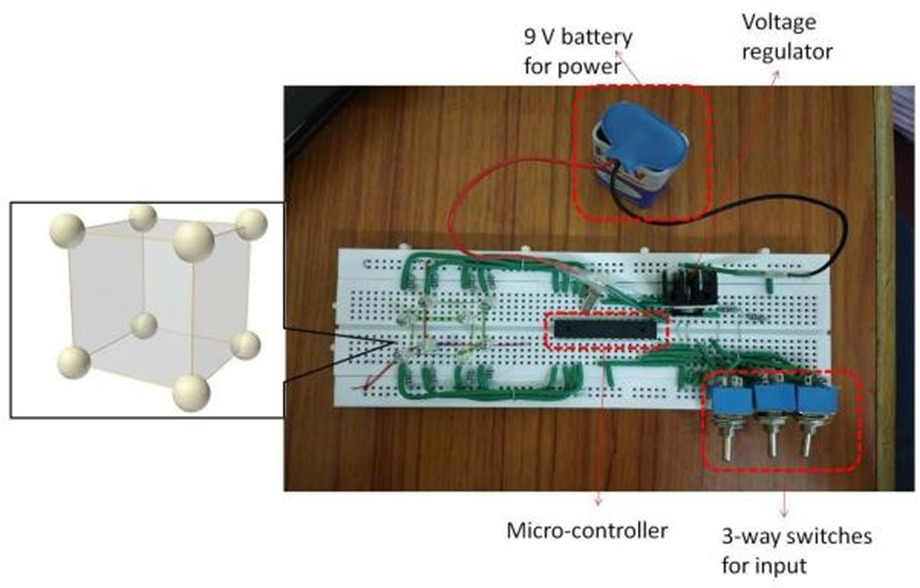The Interactive Optical System is an educational and demonstration tool designed to visualize 3D crystal structures and chemical reactions using configurable light patterns. Through the use of three-way switches, users can simulate and illuminate atomic planes corresponding to Miller indices in real-time. This system enhances the understanding of crystallographic and molecular behavior by representing motifs on various planes in lattice structures such as Simple Cubic (SC), Body-Centered Cubic (BCC), and Face-Centered Cubic (FCC). The system also supports visualization of organic chemistry concepts like resonance, charge distribution, and reaction mechanisms using programmable LEDs.
Understanding complex 3D crystal structures in solid-state chemistry is challenging due to the abstract nature of atomic arrangements and Miller planes, which require strong spatial visualization skills. Traditional tools like molecular model kits are static and non-interactive, limiting users’ ability to highlight specific atoms or planes dynamically. This makes it difficult to visualize and correlate structural features with material properties. Therefore, there is a need for an interactive optical system that enables real-time visualization and manipulation of 3D crystal lattices, enhancing understanding and engagement.
- Interactive 3D Visualization: The innovation enables dynamic representation of crystal planes and molecular motifs using LED lighting.
- Multi-Lattice Support: It is compatible with simple cubic, body-centered cubic, and face-centered cubic lattices.
- User-Controlled Operation: Three-way switches allow intuitive selection of miller indices and corresponding planes.
- Real-Time Feedback: The microcontroller processes input and updates LED patterns instantly for seamless interaction.
- Educational Utility: It simplifies complex chemical and crystallographic concepts for students and researchers.
- Portability: Its compact design allows easy transport and use in various learning environments.
- Customizable Displays: It can represent different chemical reactions and resonance structures by changing LED colors and patterns.
The prototype of the interactive optical system consists of a three-dimensional lattice framework mounted on a control box. The lattice represents crystallographic planes with miller indices, and is equipped with multiple LED light sources arranged to correspond to atoms or motifs within the lattice. Three-way switches allow users to select different miller index combinations, which the microcontroller reads as input to control lighting patterns on the lattice. The system visually demonstrates molecular and crystallographic phenomena such as resonance, reaction steps, and atomic arrangements through dynamic LED illumination and color changes. Power is supplied via a battery holder integrated into the control box, enabling portability. The microcontroller is programmed to detect switch positions, process inputs, and control the LEDs accordingly to represent various chemical reactions and crystal structures interactively.
The product based on this technology has been developed and is being used by KV, IITB, as a teaching aid for solid-state chemistry.
5-6
The interactive optical system offers a transformative approach to science education and research by providing a hands-on, visual tool to explore complex three-dimensional chemical and crystallographic structures. It enhances learning by making abstract concepts tangible, improving comprehension and engagement in STEM fields. This technology supports diverse learning styles and promotes inclusivity, with potential to accelerate innovation in material science and pharmaceuticals. Its application in industry could also improve quality control and manufacturing efficiency. Overall, the system fosters scientific literacy and innovation with broad societal benefits.
- Education Technology (EdTech)
- Chemistry and physics labs
- Engineering education (Materials Science, Nanotechnology)
- Scientific Visualization
- Crystallography and solid-state physics research
Geography of IP
Type of IP
202323017353
537807

